
Wool is the textile fibre obtained from sheep and other mammals, especially goats, rabbits, and camelids. The term may also refer to inorganic materials, such as mineral wool and glass wool, that have properties similar to animal wool.
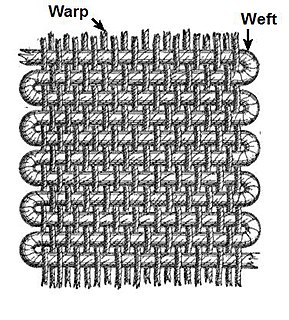
Weaving is a method of textile production in which two distinct sets of yarns or threads are interlaced at right angles to form a fabric or cloth. Other methods are knitting, crocheting, felting, and braiding or plaiting. The longitudinal threads are called the warp and the lateral threads are the weft, woof, or filling. The method in which these threads are interwoven affects the characteristics of the cloth. Cloth is usually woven on a loom, a device that holds the warp threads in place while filling threads are woven through them. A fabric band that meets this definition of cloth can also be made using other methods, including tablet weaving, back strap loom, or other techniques that can be done without looms.

Quipu are recording devices fashioned from strings historically used by a number of cultures in the region of Andean South America.

Biella is a city and comune in the northern Italian region of Piedmont, the capital of the province of the same name, with a population of 44,324 as of 31 December 2017. It is located about 80 kilometres northeast of Turin and about 80 kilometres west-northwest of Milan.
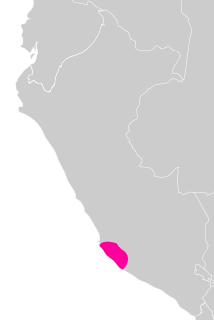
The Nazca culture was the archaeological culture that flourished from c. 100 BC to 800 AD beside the arid, southern coast of Peru in the river valleys of the Rio Grande de Nazca drainage and the Ica Valley. Strongly influenced by the preceding Paracas culture, which was known for extremely complex textiles, the Nazca produced an array of crafts and technologies such as ceramics, textiles, and geoglyphs.

The Chincha culture was the culture of a Native Peruvian people living near the Pacific Ocean in south west Peru. The Chincha Kingdom and their culture flourished in the Late Intermediate Period, also known as the regional states period of pre-Columbian Peru. They became part of the Inca Empire around 1480. They were prominent as sea-going traders and lived in a large and fertile oasis valley. La Centinela is an archaeological ruin associated with the Chincha. It is located near the present-day city of Chincha Alta.

Fetternear Bishop's Palace is an archaeological site of what was one of the palaces of the medieval bishops of Aberdeen. It is near Kemnay in Aberdeenshire. Later, a ruined tower-house and mansion of Fetternear House were built on part of the site.

The Andean textile tradition once spanned from the Pre-Columbian to the Colonial era throughout the western coast of South America, but was mainly concentrated in Peru. The arid desert conditions along the coast of Peru have allowed for the preservation of these dyed textiles, which can date to 6000 years old. Many of the surviving textile samples were from funerary bundles, however, these textiles also encompassed a variety of functions. These functions included the use of woven textiles for ceremonial clothing or cloth armor as well as knotted fibers for record-keeping. The textile arts were instrumental in political negotiations, and were used as diplomatic tools that were exchanged between groups. Textiles were also used to communicate wealth, social status, and regional affiliation with others. The cultural emphasis on the textile arts was often based on the believed spiritual and metaphysical qualities of the origins of materials used, as well as cosmological and symbolic messages within the visual appearance of the textiles. Traditionally, the thread used for textiles was spun from indigenous cotton plants, as well as alpaca and llama wool.
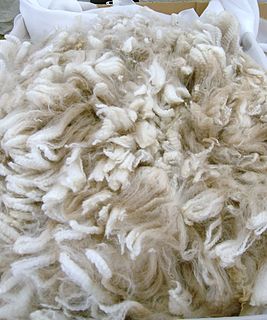
Alpaca fleece is the natural fiber harvested from an alpaca. There are two different types of alpaca fleece. The most common fleece type comes from a Huacaya. Huacaya fiber grows and looks similar to sheep wool in that the animal looks "fluffy". The second type of alpaca is Suri and makes up less than 10% of the South American alpaca population. Suri fiber is more similar to natural silk and hangs off the body in locks that have a dreadlock appearance. While both fibers can be used in the worsted milling process using light weight yarn or thread, Huacaya fiber can also be used in a woolen process and spun into various weight yarns. It is a soft, durable, luxurious and silky natural fiber.

The alpaca is a species of South American camelid mammal. It is similar to, and often confused with, the llama. However, alpacas are often noticeably smaller than llamas. The two animals are closely related and can successfully crossbreed. Both species are believed to have been domesticated from their wild relatives, the vicuña and guanaco. There are two breeds of alpaca: the Suri alpaca and the Huacaya alpaca.
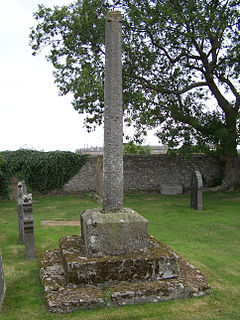
Kinneddar is a small settlement on the outskirts of Lossiemouth in Moray, Scotland, near the main entrance to RAF Lossiemouth. Long predating the modern town of Lossiemouth, Kinneddar was a major monastic centre for the Pictish kingdom of Fortriu from the 6th or 7th centuries, and the source of the important collection of Pictish stones called the Drainie Carved Stones. The Kirk of Kinneddar was the cathedral of the Diocese of Moray between 1187 and 1208, and remained an important centre of diocesan administration and residence of the Bishop of Moray through the 13th and 14th centuries.

Natural dyes are dyes or colorants derived from plants, invertebrates, or minerals. The majority of natural dyes are vegetable dyes from plant sources—roots, berries, bark, leaves, and wood—and other biological sources such as fungi.

Christina of the Isles was a fourteenth-century Scottish noblewoman. She was daughter of Ailéan mac Ruaidhrí, and a leading member of Clann Ruaidhrí. Although Ailéan had two sons, Lachlann and Ruaidhrí, both appear to have been illegitimate, whereas Christina was legitimate, and possibly a daughter of Ailéan's wife, Isabella.
Dubhghall mac Suibhne was a prominent thirteenth-century landholder in Argyll, and a leading member of Clann Suibhne. He was a son of Suibhne mac Duinn Shléibhe, and appears to have held lordship of Knapdale from at least the 1240s to the 1260s, and may have initiated the construction of Skipness Castle and Lochranza Castle.

The Tiwanaku Polity was a Pre-Columbian polity in western Bolivia based in the southern Lake Titicaca Basin. Tiwanaku was one of the most significant Andean civilizations. Its influence extended into present-day Peru and Chile and lasted from around 600 to 1000 AD. Its capital was the monumental city of Tiwanaku, located at the center of the polity's core area in the southern Lake Titicaca Basin. This area has clear evidence for large-scale agricultural production on raised fields that probably supported the urban population of the capital. Researchers debate whether these fields were administered by a bureaucratic state (top-down) or through a federation of communities with local autonomy. Tiwanaku was once thought to be an expansive military empire, based mostly on comparisons to the later Inca Empire. However, recent research suggests that labelling Tiwanaku as an empire or even different varieties of a state may even be misleading. Tiwanaku is missing a number of features used to define these types of polities: there is no defensive architecture at any Tiwanaku site or changes in weapon technology, there are no princely burials or other evidence of a ruling dynasty or a formal social hierarchy, no evidence of state-maintained roads or outposts, and no markets.

Acamarachi is a 6,046-metre (19,836 ft) high volcano in northern Chile. In this part of Chile, it is the highest volcano. Its name means "black moon". It is a volcano in the Central Volcanic Zone of the Andes, a zone of strong volcanic activity during the last million years. Old volcanoes in the area are well-preserved, due to the dry climate.
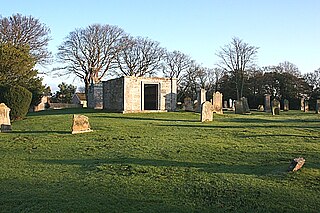
Holy Trinity Church, Spynie was until 1735 the parish church of Spynie, Moray in north-east Scotland, and served as the cathedral of the Diocese of Moray between 1207 and 1224.
Pamela Marshall is an archaeologist and historian specialising in the study of castles. Marshall was elected as a Fellow of the Society of Antiquaries of London in 2007. She worked at the University of Nottingham, teaching in the departments of archaeology and continuing education until her retirement. Marshall's research on castles has examined castles in England and France, as they had a shared castle culture, and is an authority on great towers. Between 2000 and 2014, Marshall was chair/secretary of the Castle Studies Group and is Comité Permanent of the Colloques Château Gaillard, a biannual conference for castellologists.

Irene Emery (1900–1981) was an American art historian, scholar, curator, textile anthropologist, sculptor, and modern dancer. She was known for her pioneering research in systematically describing global textiles, and was a leading authority on ancient fabrics and textiles, and for her published book The Primary Structures of Fabrics: An Illustrated Classification (1966).

Vicuña wool refers to the hair of the South American vicuña, an animal of the family of camelidae. The wool has, after shahtoosh, the second smallest fiber diameter of all animal hair and is the most expensive legal wool.




















